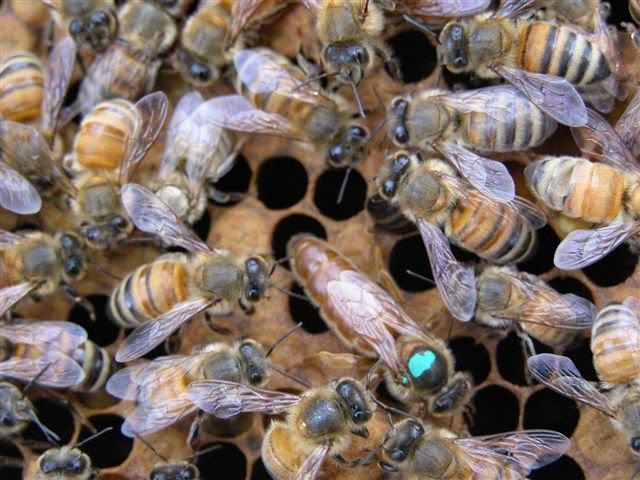Post by cff on Nov 13, 2008 7:44:14 GMT -5
I raise Aseels or Asils as some call them, the worlds oldest poultry. There health is important to me so I've searched out some goodies over the years.
Free range is a major plus for poultry health, you all already know that but if you can't do this? My Aseels cockerels will fight and kill each other at a young age, free range for them (and some hens) is not possible after their about three months old.
Poultry still need live enzymes and they can't get it from heat processed pellets because there completely dead. Least cost formulation is used to provide the minimum requirements at the cheapest cost. The heat process (steam conditioning) also destroys the natural vitamins, synthetic vitamins and minerals are added to replace what the heat process has destroyed. One major difference in grower feeds and layer feeds is the amount of added synthetic vitamins. The most common issues with poultry are from the lack of good quality (live nutrition and enzymes)
So here are a few tricks I've learned over the years.
Moveable pens (the chicken tractor) move them to a new location daily = new fresh grass and clover daily.
Build some shallow boxes and cover with poultry wire. Plant the boxes with wheat / Oats and feed the young sprouts to your poultry by placing the box in the hen house, the wire will prevent them from scratching out the roots. After the sprouts have been ate down to the wire remove and water = new sprouts in a week.
Drive up a 16 penny nail inside the pen at the roosting pole for a cabbage head or a pealed apple .Cheap and easy way to keep live feed off the floor of the pen.
Add a cup of Braggs Apple Cider Vinegar (with the mother) to five gallons of feed. It will smell like a salad and poultry will fight over the feed. Great health booster for you and your poultry! You can also add a few ounces to there water. This may be the single best (every day thing) I ever found for the over-all health of my poultry.
If you have a juicer -juice any garden vegetable leftovers with two cloves of garlic and pour a cup full of the juice over there feed a few times a week, you wont have any poultry mites and intestinal parasites will be few with the addition of a few cloves of garlic.
(I use cheap grocery store carrots or celery) and garlic here = I never spend any money on wormers and my poultry are in perfect health.
Save your egg shells; crush them into there feed = 100% perfect calcium source for poultry 100% digestible.
The molt is a time of stress pulling a lot of protein from the hens to produce feathers, boost there protein level with any leftover eggs (boil and crush them in there feed) Add crushed or chopped (hot pepper) to you feed to help re-start the hens laying. (takes about a week of feeding pepper to re-start a hen in good health)
Hens that eat there own eggs are begging for protein. Isolate them and feed them nothing but boiled eggs for a few days to stop this problem.
A boiled egg is = to a vitamin shot for poultry; I start chicks on a diet of 20% fresh cracked grain and 80% boiled eggs (almost never lose any chicks)
Soak your grains for 48 hours; drain for 2 to 4 hours before feeding. You can add powdered poultry vitamins to the soak water for a little extra kick.
The water helps to remove pesticides that may have been applied and sprouted grains have more protein.
I place my grain in a five gallon bucket with small holes drilled in the bottom of the bucket, I wash the grain with the garden hose for a few minutes and then I sit the bucket a larger bucket of water. When I'm ready to feed the soaked grains I just remove the bucket with the holes from the larger bucket. Most of the time I let it drain outside for a few hours before feeding time. Remove any grain that floats after 24 hours (its is trash)
Weight your grain to check the quality, a cubic foot of good quality corn should weigh about 56 lbs. Corn that has been stored for extended periods will dry out and have much less nutritional value (it will also have more pesticides applied to prevent damage while in storage)
A quick Internet search will give you all the cubic foot weights for almost any kind of whole grain.
A grain is like an apple, once the skin is broken it starts to dry out and the nutritional value starts to decline rapidly, feed whole grains when ever possible. For my chicks I crack the grain a few minuets before feeding time.
Soaked Whole Oats can ferment in water in about five days, the worse they smell the better poultry like them. This is 50% of my ration and I keep some soaking year round.
Most any hot pepper will work, if its fresh out of the garden I chop it up and mix it into there feed. I always feed in clean feeder pans and try not to feed more than the birds can clean up in 10 - 15 minutes twice a day.
This helps to keep the mice at a manageable level and the birds pick up less bacteria than they would if fed on the ground.
Ground cayenne pepper sticks to a damp feed really well, if you've soaked your grains or used organic vinegar on your feed.
As an added bonus 5 of the 9 different strains of coccidiosis can't live in a the high PH provided by the vinegar.
The white of an egg has a Ph of 9 the yoke is 6.5
The high PH of the white protects the yoke from bad bacteria, viruses, and fungi.
When you combine both the white and the yoke on your plate it has a perfect Ph of 7.75.
Baking Soda has a Ph of 8.0, Its a cheap addition to your poultry water if you don't use vinegar @ A table spoon per gallon.
A whole egg is 65.5% water, so clean water with a high Ph is a must have for healthy poultry.
The very best breeder feeds use fish meal for a meat protein source, a sprinkle of fish meal over your damp feed is a good addition to any ration.
Two table spoons of flax seed in 4 - 6 ounces of water heated to a boil will make a slimy soup that does wonders for the shine on feathers if your into showing poultry. Add the mixture over your feed daily and watch the feathers come to life. Used just enough to dampen dry feed.
Free range is a major plus for poultry health, you all already know that but if you can't do this? My Aseels cockerels will fight and kill each other at a young age, free range for them (and some hens) is not possible after their about three months old.
Poultry still need live enzymes and they can't get it from heat processed pellets because there completely dead. Least cost formulation is used to provide the minimum requirements at the cheapest cost. The heat process (steam conditioning) also destroys the natural vitamins, synthetic vitamins and minerals are added to replace what the heat process has destroyed. One major difference in grower feeds and layer feeds is the amount of added synthetic vitamins. The most common issues with poultry are from the lack of good quality (live nutrition and enzymes)
So here are a few tricks I've learned over the years.
Moveable pens (the chicken tractor) move them to a new location daily = new fresh grass and clover daily.
Build some shallow boxes and cover with poultry wire. Plant the boxes with wheat / Oats and feed the young sprouts to your poultry by placing the box in the hen house, the wire will prevent them from scratching out the roots. After the sprouts have been ate down to the wire remove and water = new sprouts in a week.
Drive up a 16 penny nail inside the pen at the roosting pole for a cabbage head or a pealed apple .Cheap and easy way to keep live feed off the floor of the pen.
Add a cup of Braggs Apple Cider Vinegar (with the mother) to five gallons of feed. It will smell like a salad and poultry will fight over the feed. Great health booster for you and your poultry! You can also add a few ounces to there water. This may be the single best (every day thing) I ever found for the over-all health of my poultry.
If you have a juicer -juice any garden vegetable leftovers with two cloves of garlic and pour a cup full of the juice over there feed a few times a week, you wont have any poultry mites and intestinal parasites will be few with the addition of a few cloves of garlic.
(I use cheap grocery store carrots or celery) and garlic here = I never spend any money on wormers and my poultry are in perfect health.
Save your egg shells; crush them into there feed = 100% perfect calcium source for poultry 100% digestible.
The molt is a time of stress pulling a lot of protein from the hens to produce feathers, boost there protein level with any leftover eggs (boil and crush them in there feed) Add crushed or chopped (hot pepper) to you feed to help re-start the hens laying. (takes about a week of feeding pepper to re-start a hen in good health)
Hens that eat there own eggs are begging for protein. Isolate them and feed them nothing but boiled eggs for a few days to stop this problem.
A boiled egg is = to a vitamin shot for poultry; I start chicks on a diet of 20% fresh cracked grain and 80% boiled eggs (almost never lose any chicks)
Soak your grains for 48 hours; drain for 2 to 4 hours before feeding. You can add powdered poultry vitamins to the soak water for a little extra kick.
The water helps to remove pesticides that may have been applied and sprouted grains have more protein.
I place my grain in a five gallon bucket with small holes drilled in the bottom of the bucket, I wash the grain with the garden hose for a few minutes and then I sit the bucket a larger bucket of water. When I'm ready to feed the soaked grains I just remove the bucket with the holes from the larger bucket. Most of the time I let it drain outside for a few hours before feeding time. Remove any grain that floats after 24 hours (its is trash)
Weight your grain to check the quality, a cubic foot of good quality corn should weigh about 56 lbs. Corn that has been stored for extended periods will dry out and have much less nutritional value (it will also have more pesticides applied to prevent damage while in storage)
A quick Internet search will give you all the cubic foot weights for almost any kind of whole grain.
A grain is like an apple, once the skin is broken it starts to dry out and the nutritional value starts to decline rapidly, feed whole grains when ever possible. For my chicks I crack the grain a few minuets before feeding time.
Soaked Whole Oats can ferment in water in about five days, the worse they smell the better poultry like them. This is 50% of my ration and I keep some soaking year round.
Most any hot pepper will work, if its fresh out of the garden I chop it up and mix it into there feed. I always feed in clean feeder pans and try not to feed more than the birds can clean up in 10 - 15 minutes twice a day.
This helps to keep the mice at a manageable level and the birds pick up less bacteria than they would if fed on the ground.
Ground cayenne pepper sticks to a damp feed really well, if you've soaked your grains or used organic vinegar on your feed.
As an added bonus 5 of the 9 different strains of coccidiosis can't live in a the high PH provided by the vinegar.
The white of an egg has a Ph of 9 the yoke is 6.5
The high PH of the white protects the yoke from bad bacteria, viruses, and fungi.
When you combine both the white and the yoke on your plate it has a perfect Ph of 7.75.
Baking Soda has a Ph of 8.0, Its a cheap addition to your poultry water if you don't use vinegar @ A table spoon per gallon.
A whole egg is 65.5% water, so clean water with a high Ph is a must have for healthy poultry.
The very best breeder feeds use fish meal for a meat protein source, a sprinkle of fish meal over your damp feed is a good addition to any ration.
Two table spoons of flax seed in 4 - 6 ounces of water heated to a boil will make a slimy soup that does wonders for the shine on feathers if your into showing poultry. Add the mixture over your feed daily and watch the feathers come to life. Used just enough to dampen dry feed.









